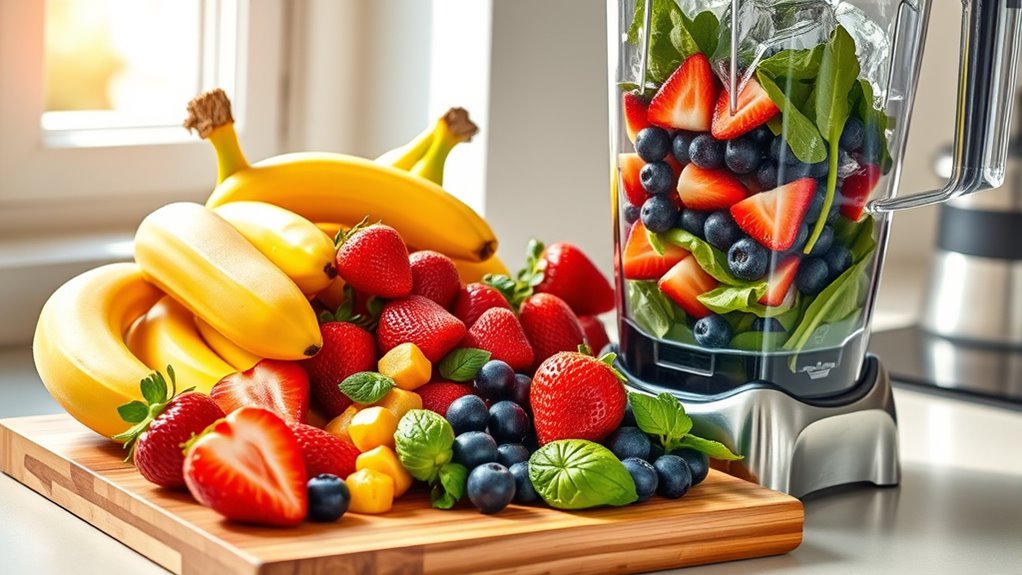For a healthy fruit smoothie, aim for 1 to 1.5 cups of mixed fruit, like banana and berries, plus spinach or chia seeds for nutrients like potassium and omega-3. Wash and chop your fruits evenly; freeze some for a thicker texture. Blend liquids first, then fruits, and serve immediately in a clear glass for freshness. Choose unsweetened frozen fruit and moderate portions to keep calories balanced. Keep going to discover tips on perfect blending and nutrient boosts.
Ingredients and Quantity

When crafting a healthy fruit smoothie, choosing the right ingredients and their quantities is essential to balance taste and nutrition. You want fruit combinations that offer a nutrient balance—vitamins, fiber, and natural sweetness without excess sugar. Typically, aim for about 1 to 1.5 cups of mixed fruit per serving. Adding a small portion of leafy greens or a spoonful of seeds can enhance nutrient density without overpowering flavor.
| Ingredient | Quantity | Nutritional Benefit |
|---|---|---|
| Banana | 1 medium | Potassium, natural sweetness |
| Berries (mixed) | 1 cup | Antioxidants, fiber |
| Spinach | 1/2 cup | Iron, vitamins A & C |
| Chia seeds | 1 tbsp | Omega-3, protein |
Using these proportions helps you enjoy freedom in flavor while maintaining health.
Preparations

Selecting the right ingredients is just the start; how you prepare them can greatly impact the final smoothie’s texture and flavor. To get the best results, always wash your seasonal fruits thoroughly to remove pesticides and dirt. Peel or chop fruits like mangoes or pineapples into uniform pieces to guarantee smooth blending and consistent texture. If you want to experiment with smoothie variations, try freezing fruits ahead of time—this adds thickness without diluting flavor. Remember, removing seeds or tough skins, such as from kiwis or berries, can prevent bitterness and improve mouthfeel. Prepping your ingredients thoughtfully not only preserves nutrients but also enhances taste, giving you the freedom to enjoy diverse, healthy smoothies that suit your personal preferences and the season’s freshest offerings.
How to Prepare

- Wash and cut fresh fruits into uniform pieces to ensure even blending.
- Add frozen fruits or a handful of ice for a creamier texture.
- Use layering techniques by placing liquids first, followed by softer ingredients, and firmer ones on top to optimize blending efficiency.
- Experiment with blending techniques such as pulsing or continuous blending to achieve your desired consistency.
- Consider adding leafy greens, nuts, or seeds for extra nutrients and texture.
- Master these preparation methods to maintain control over flavor balance and texture, resulting in a revitalizing, nutrient-rich smoothie tailored to your preferences.
How to Serve

After preparing your smoothie with care, how you serve it can enhance both its appeal and nutritional benefits. Start by considering appropriate serving sizes—typically 8 to 12 ounces—to guarantee you get enough nutrients without overindulging. Use clear glassware to showcase the vibrant colors, which naturally stimulate appetite and enjoyment. Adding simple garnishing options like fresh fruit slices, a sprinkle of chia seeds, or a few mint leaves can elevate the presentation and add subtle flavor or texture. Serving immediately preserves the smoothie’s nutrient content and freshness, while chilled glasses can keep it invigorating longer. By paying attention to these details, you not only enjoy your smoothie’s health benefits but also create a moment of freedom and pleasure in your daily routine.
Tips

When crafting your fruit smoothie, paying attention to ingredient quality and balance can greatly impact both taste and nutrition. Choose fresh or frozen fruits without added sugars for ideal flavor and health benefits. Don’t hesitate to explore smoothie variations by mixing different fruits, greens, and liquids like almond milk or coconut water. If you’re missing an ingredient, consider sensible substitutions—for example, swap spinach for kale or yogurt for a plant-based alternative—without compromising texture or nutrient density. Keep your portion sizes moderate to avoid excessive calories, and blend ingredients thoroughly for a smooth, enjoyable consistency. By experimenting thoughtfully with these tips, you maintain control over your smoothie’s nutritional profile while embracing the freedom to customize it to your liking.
Food Value and Benefit
Prepared fruit smoothies provide a nutrient-dense dish packed with essential vitamins, minerals, fiber, and antioxidants. By blending a variety of fresh fruits, this recipe delivers a balanced combination of macronutrients and micronutrients that support overall health.
Benefits of eating fruit smoothies include:
- Rich in vitamin C, which strengthens the immune system and promotes healthy skin
- Contains vitamin A and antioxidants that support eye health and reduce inflammation
- High in dietary fiber, aiding digestion and promoting satiety to help with weight management
- Provides essential minerals such as potassium and magnesium that help maintain muscle function and regulate blood pressure
- Hydrating due to the high water content in fruits, contributing to optimal fluid balance
Incorporating fruit smoothies into your diet offers an easy and delicious way to nourish your body, boost energy levels, and maintain overall well-being.
